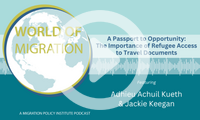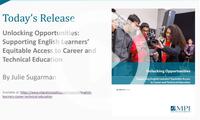Education
Recent Activity

Travel documents play an important role in international mobility, and for refugees serve as an essential gateway to a world of opportunities, from pursuing education and employment to reuniting with family. This episode unpacks the complexities around travel documents and their pivotal role in refugees' livelihoods.
Marking the launch of a report by the American Academy of Pediatrics and MPI, this event examines unaccompanied children’s access to medical and mental health services post-release and offering recommendations for improvements.

This webinar, marking the launch of a report, looks at career and technical education programs and federal, state, and school district policies that support English Learners' inclusion in these programs.

Language access policies and services are critical to promoting the equitable participation of Dual Language Learners and their families in early childhood programs, yet there are persisting participation gaps. This webinar outlines federal and state efforts to implement language access policies in the early childhood field, along with opportunities to improve language services.

Marking the release of a report examining the assessment of English Learner (EL) students after pandemic-induced disruptions, this webinar examines ELs’ learning experiences during the 2020-21 academic year and their performance and participation in statewide testing, and how schools are using data to inform interventions and instruction this year.
Pages
Recent Activity
Some of the strictest COVID-19 pandemic-era limits on human mobility occurred in the Asia Pacific region. Border closures started in East and Southeast Asia in early 2020 and quickly spread through the entire region, in some cases remaining in place for more than two years. This report examines the approaches countries took and reflects on the immense costs and benefits of using border measures to tackle public-health risks.
















Investing in the Future: Higher Ed Should Give Greater Focus to Growing Immigrant-Origin Student Population
Apprenticeship Programs Are a Promising Solution to Bring More Multilingual Workers into Early Childhood Field
How State Assessments Became and Remain a Driver for Equity for English Learners
Schools Should Engage Diverse Community Stakeholders to Promoting Equitable Allocation of Historic Funding to Reimagine Education
Narrowing the Skills Gap: Equipping Immigrant-Origin Workers with Postsecondary Credentials
Labor Shortages during the Pandemic and Beyond: What Role Can Immigration Policy Play?
Achieving the “Partnership” in the European Union’s Talent Partnerships
Rebuilding the U.S. Education System for the Nation’s English Learners
A Deeper Look at the DREAMers Who Could Feature in the Legalization Debate in Congress
How the Fear of Immigration Enforcement Affects the Mental Health of Latino Youth
Pages